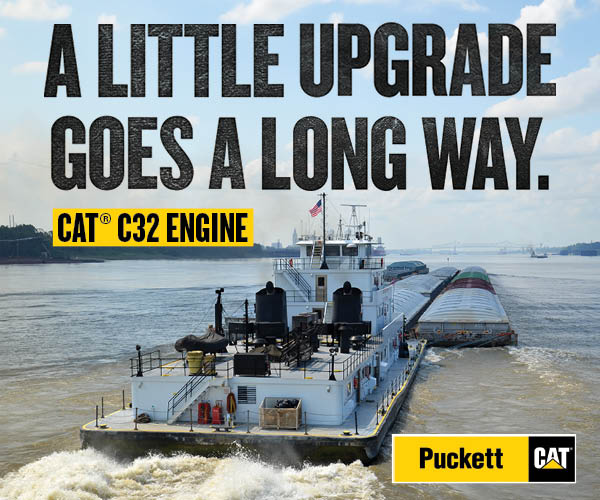IMX Session Focuses On Infrastructure, Funding
A trio of panelists during an Inland Marine Expo (IMX) education session looked at waterway infrastructure across the country and the challenge of project reliability and cost overruns. Paul Rohde, vice president for the Midwest area for Waterways Council Inc. (WCI), moderated the session, which also featured Neil Maunu, executive director of the Pacific Northwest Waterways Association (PNWA), Tennessee River Valley Association Executive Director Cline Jones and WCI President and CEO Tracy Zea.
Maunu’s organization represents about 150 operators and stakeholders of waterways in the Pacific Northwest, including the Columbia and Snake rivers, along the Oregon coast and Puget Sound. The Columbia Snake River System includes a 105-mile-long deep-draft channel of 43 feet between Astoria, Ore., and Portland and a 360-mile shallow-draft channel on the Snake River up to Lewiston, Idaho. About a tenth of all wheat exports in the United States travel on the Columbia Snake River System, moving by barge through the system’s eight locks.
PNWA is involved with advocating for federal funding for the waterway, Maunu said, along with economic development and legal advocacy for the waterway.
Maunu also described the partnership that operators on the system have with the Corps, which includes regular system-wide closures. The system, Maunu said, closes for two to three weeks each year for regular maintenance and for around 15 weeks every six or seven years. Maunu said those closures, obviously, aren’t easy for operators and shippers, but stakeholders also recognize the benefits that come from them.
“Yeah, it hurts,” Maunu said, “but you know what? The stakeholders and the customers and shippers are getting used to it, and they love the predictability and reliance on our system.”
An ongoing challenge to navigation on the Columbia Snake River System comes from various groups that advocate for removing locks and dams along the waterway. Groups argue that’s necessary to restore the natural habitat for salmon traveling up and down the river system, but Maunu said facts are on the side of the locks and dams, which include fish passage features. The survival rate for juvenile fish traveling along the waterway, Maunu said, is more than 97 percent.
“People just have to look at the facts,” he said. “We have tons of facts. We have the most efficient way to move cargo commodities. We can have salmon habitat restoration and recovery.”
In contrast to Maunu, Jones identified “perceived reliability” as a challenge for operators and economic developers on the Tennessee River and downstream on the Black Warrior-Tombigbee and Tennessee-Tombigbee waterways. In 2024, there were three emergency closures at locks on those systems, starting with a miter sill failure at Demopolis Lock on the Tombigbee River. That lock reopened in May 2024, but less than a month later cracks in a monolith at Holt Lock on the Black Warrior River closed it to navigation. Then, in September 2024, cracking noises at Wilson Lock on the Tennessee River in Florence, Ala., forced its closure. Add to that cost overruns and delays at both Kentucky Lock and Chickamauga Lock, and Cline said it’s a stressful time for waterway stakeholders in his region.
“We’ve got to take care of these systems,” he said. “We’ve got to get some money in these systems, and we’ve got to maintain them to ensure this doesn’t happen.”
Zea painted a grim picture for locks and dams on the western rivers. Looking at all operational inland and coastal navigation locks owned by the Corps of Engineers or the Tennessee Valley Authority, excluding control structures, more than 80 percent are greater than 50 years old. Only three are 10 years old or younger. Two are between 11 and 20 years old, and another two are between 21 and 30 years old.
“Each year they go past 50 years old, the risk of failure goes up exponentially,” Zea said.
Zea was blunt with his criticism of how the Corps of Engineers executes new construction projects.
“This is what keeps me and my team at WCI up at night, and it’s a major concern,” he said. “If the Corps continues to take forever to construct these locks and dams, we’re not going to flip this chart. There’s going to have to be something done other than the Corps of Engineers constructing these locks and dams, because it can’t continue to go on like this.”
Zea said a bright spot in an otherwise grim reality is that, over the past 11 years, Congress has appropriated $5.1 billion for waterway infrastructure above what has been requested in the president’s budget.
“The problem is, with this $5.1 billion, we only got two locks operational and one major rehab, where we should have at least five new locks operational,” Zea said.
Zea argued that fundamental changes need to be put in place.
Rohde said raising awareness and advocating for change is part of WCI’s mission.
“You can’t turn this boat around quickly,” Rohde said, “but we’ve been working at it, and we’ll continue to work at it.”
Editor’s note: Watch for more coverage of IMX in future issues of The Waterways Journal.



